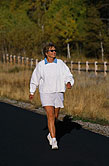- Skip Storing This Everyday Product in the Fridge Door
- Green Tea + B3 Pairing May Boost Brain Health
- Navigating Your Midlife Crisis: Embracing New Possibilities
- City Raccoons Showing Signs of Domestication
- Mapping the Exposome: Science Broadens Focus to Environmental Disease Triggers
- One Week Less on Social Media Linked to Better Mental Health
- Your Brain Changes in Stages as You Age, Study Finds
- Some Suicide Victims Show No Typical Warning Signs, Study Finds
- ByHeart Formula Faces Lawsuits After Babies Sickened With Botulism
- Switch to Vegan Diet Could Cut Your Greenhouse Gas Emissions in Half
Realistic Targets May Boost Exercise Rates, Experts Say


People who are sedentary should focus on small increases in their activity level and not dwell on public health recommendations on exercise, according to new research.
Current targets call for 150 minutes of weekly exercise — or 30 minutes of physical activity at least five days a week — to reduce the risk of chronic diseases such as diabetes and heart disease.
Although these standards don’t need to be abandoned, they shouldn’t be the primary message about exercise for inactive people, experts argued in two separate analyses in the Jan. 21 BMJ.
When it comes to improving health and well-being, some activity is better than none, according to one of the authors, Phillip Sparling, a professor in the School of Applied Physiology at Georgia Institute of Technology in Atlanta.
“Think of exercise or physical activity as a continuum where one wants to move up the scale a bit and be a little more active, as opposed to thinking a specific threshold must be reached before any benefits are realized,” he said.
For people who are inactive or dealing with chronic health issues, a weekly goal of 150 minutes of exercise may seem unattainable. As a result, they may be discouraged from trying to work even a few minutes of physical activity into their day, Sparling said.
People who believe they can’t meet lofty exercise goals often do nothing instead, according to Jeffrey Katula, an associate professor in the Department of Health & Exercise Science at Wake Forest University in Winston-Salem, N.C. This “all or nothing” mindset is common, he said.
Health benefits can be achieved by doing less than the recommended amount of physical activity, according to the second analysis’ author, Philipe de Souto Barreto, from the University Hospital of Toulouse, France.
For example, his review of six studies found that compared with doing nothing, walking one to 74 minutes weekly can reduce the risk of death from any cause by 19 percent.
Essentially, the more physical activity you do, the more of a response you’ll get, explained Katula. “Some exercise is better than none, but more is better than that,” he said.
Minor increases in physical activity may gradually lead to more intense exercise, noted Sparling. “Once a routine and mindset are established, adding more activity may be easier,” he said.
But can a five-minute stroll really improve your health? The health benefits of exercise will vary depending on how much you get and what type of activity you are doing, but that’s not really the message, according to Sparling.
“The main point is that more walking and light activity for habitually sedentary older persons can improve general well-being and one’s ability to sustain routine daily activities,” he said.
Guidelines for exercise shouldn’t be a “one-size-fits-all” scenario for the entire population, the experts suggested.
Sparling and his co-authors said discussions of exercise for people who’ve been sedentary should focus on two simple goals: sitting less and moving more. They recommend standing or strolling for at least a minute or two to break up every hour of sitting. They also recommend 30 minutes of light activity daily, such as pacing while on the phone, getting up and moving around during commercial breaks on TV, and taking several short walks throughout the day.
The key to staying motivated is to make exercise a positive experience that people will enjoy, Katula noted. He offered additional tips to help people stay motivated, including:
- Be self-aware. “Many people simply do not like exercise but refuse to admit it. People need to understand how they think and feel about physical activity,” Katula said. “There are usually good reasons why sedentary adults have been sedentary throughout their lives. Understanding these barriers can help people overcome them.”
- Know your preferences. Some people like to exercise in a group setting or walk with a friend, while others prefer to be alone. For early risers, waiting until the end of the day to work out may not be realistic. “Find what works for you and do that,” said Katula.
- Don’t give up. Everyone misses a workout or has an off day. Understanding that short-term setbacks are a normal part of the process can help people accept them and get back on track, he said.
More information
The U.S. Centers for Disease Control and Prevention provides more information on the benefits of physical activity.
Source: HealthDay
Copyright © 2025 HealthDay. All rights reserved.










